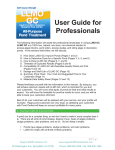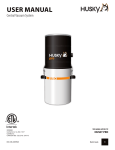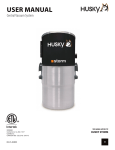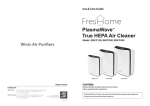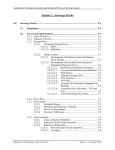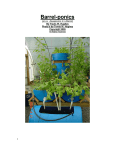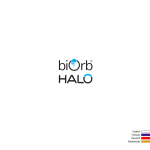Download Pond Perfect User`s Manual
Transcript
The Landscaper’s Pond Perfect User’s Manual The following information will assist the professional landscaper in using Pond Perfect. Pond Perfect is a 100% live, natural, non-toxic, non-chemical solution to excess algae blooms, pond odors, excess sludge, and string algae in decorative ponds. In the sections that follow, we will discuss: A. B. C. D. E. How Does Pond Perfect Improve Ponds (Pages 1 and 2) How to Determine Dose for a Specific Pond (Pages 3, 4, 5, and 6) How to Dose Pond Perfect (Pages 6, 7, and 8) Timetable of Expected Results (Pages 8 and 9) Compatibility of Pond Perfect with Desirable Aquatic Plants and Fish (Pages 9 and 10) F. Storage and Shelf Life of Pond Perfect (Page 10) G. Summary Price Chart: Your Cost and Suggested Price to Your Customers (Page 11) H. Material Data Safety Sheet (Pages 12 and 13) Please familiarize yourself with the information in this manual. By doing so, you will achieve optimum results with Pond Perfect, which is important for you and your customers. You will know what types of ponds to treat and what results to expect. You will know the timetable for positive results to occur, and you will be able to keep your customers informed. Best of all, your customers will be pleased with your service, and your profits will increase. Happy pond customers are very loyal, so satisfying your customers with Pond Perfect will keep an account profitable for many years. A. How Does Pond Perfect Improve Ponds A pond can be a complex thing, so we don’t want to make it more complex than it is. There are all sorts of pond shapes, degree of sun, types of algae problems, sludge problems, odor problems, and so on. So let’s keep it simple: • • Ponds have algae problems, sludge problems, and odor problems Pond Perfect helps with all three of these problems. 1|Page Algae Problems Algae problems occur whenever you have a combination of pond water, sun, N(nitrogen) and P (phosphorous). Sun and N are the biggest problems, while P contributes to a lesser degree in most ponds. The live bacteria in Pond Perfect compete with the algae for N and P food. The Pond Perfect bacteria eat N and P faster than the algae can. As a result, excess algae is eliminated. It is very important to note that Pond Perfect does not eliminate all algae. Some algae are needed to help keep oxygen in the water. Pond Perfect only eliminates the severe bloom. The best way to think about it is that Pond Perfect restores the natural balance in a pond, which means a healthy mix of natural bacteria and algae living together. By using Pond Perfect, a pond is restored to its’ natural clarity and beauty (with a proper balance between natural bacteria and algae). Sludge and Odor Problems Almost all ponds, particularly older ponds, have sludge build up. Sludge is the muck located at the bottom of the pond (see the image below): All sorts of problems happen when the sludge build up gets heavy. The pond has plenty of oxygen in the water near the top, but in the sludge at the bottom of the pond, there is very little oxygen. That means that disease-causing, odorcausing “bad bacteria” live in the sludge at the bottom of the pond. The worse the sludge build up, the greater the risk of fish disease, and the worse the odors are. Foul pond odors (usually thought of as “rotten egg smell”) come from the sludge in the bottom of the pond. Pond Perfect digests the sludge at the bottom of a pond. This means that the risk of fish disease is reduced, and foul pond odors are eliminated. Note: Pond Perfect digests organic sludge (leaves, dead algae, fish waste, etc.). Pond Perfect does not digest clay, sand or silt. 2|Page B. Ways to Determine Dose for a Specific Pond Ponds come in all sizes, shapes and depths. There are some simple guidelines that you need to know in order to make sure that Pond Perfect is used where it is going to work, and what you can achieve in each type of pond. A simple and effective way to characterize ponds is to think of just four things: • • • • Usually, the Dose is Based on Surface Area of Pond Increase the Dose 33% for Very Deep Ponds Ponds with Rapid Flow Through Are Not Treatable Use a Special Program for Certain Shallow Ponds Pond Perfect Dose Based on Surface Area For most ponds (more than 80% of all ponds you will treat), you can simply use the chart below to determine the WEEKLY dose of Pond Perfect. For this chart, the dose is based on the surface area of the pond (either in square feet or in acres). STANDARD POND PERFECT DOSAGE CHART (WEEKLY DOSE) Up to (Square Feet) (Acres) Approx Length x Width (ft) Pond Perfect Dose per Week 25 50 125 250 400 600 750 1,000 1,750 3,500 22,000 44,000 65,000 130,000 220,000 325,000 435,000 650,000 N/A N/A N/A N/A N/A N/A N/A N/A N/A N/A 0.5 1 2 3 5 8 10 15 5x5 7x7 11 x 11 16 x 16 20 x 20 24 x 24 27 x 27 32 x 32 42 x 42 59 x 59 148 x 148 210 x 210 255 x 255 360 x 360 470 x 470 570 x 570 660 x 660 800 x 800 1 oz 2 oz 4 oz 6 oz 8 oz 10 oz 12 oz 16 oz 32 oz 64 oz 1.0 gal 1.5 gal 2.0 gal 3.0 gal 4.0 gal 6.0 gal 8.0 gal 10.0 gal > 650,000 And for larger than 15 acres, 10 gallons for every 15 acres 3|Page If you carefully look at the chart above, you will notice that smaller ponds get a high dose per gallon of water treated, while larger ponds get a smaller dose per gallon of water treated. That is exactly how the table is designed. From your own experience and with common sense, you know that small ponds are very dirty compared to large ponds, so small ponds get proportionately more product. A special note for solving severe problems: IF YOU ARE TREATING A POND WITH SEVERE PROBLEMS, SUCH AS EXTREME STRING ALGAE OR SCUM, DOUBLE THE DOSE UNTIL THE PROBLEM IS SOLVED, THEN REVERT TO THE STANDARD DOSE (AS LISTED IN THE CHART). Increase the Dose 33% for Very Deep Ponds (> 15 Feet Average Depth) Very deep ponds contain more water, so extra product is needed. However, everything else being equal, a the depth of a pond has little to do with how much pollution the pond gets. So while very deep ponds need extra product, the increase in dose is not that much. First, we consider very deep ponds to have an average depth of 15 feet or more. Not many of the ponds you treat will have an average depth of 15 feet or more. Many ponds will have a deepest point of 15 feet, but we are not worried about the maximum depth. We are concerned with the average depth. If the AVERAGE depth of a pond is 15 feet or more, use the Standard Dosage Table, but increase the dose by 33% (one third). Ponds with Rapid Flow Through Are NOT Treatable with Pond Perfect Pond Perfect needs a few days to work. Pond Perfect is a live, natural bacterial product. It is not a chemical. If a pond has rapid flow going through it, where the holding time in the pond is less than a seven days, Pond Perfect will not usually help. In the vast majority of situations, ponds are static, meaning that they have little or zero flow going through them. In just a few cases, the holding time is too short for Pond Perfect to be effective. Here is how you can tell the difference: To calculate the holding time of a pond, you take the total pond volume (in gallons) and divide by the gallons of water per day flowing through the pond. We do not recommend use of Pond Perfect if the holding time is seven days or less. Two examples follow (one with enough holding time, another with short, insufficient holding time). 4|Page Example 1: Enough Holding Time. Pond volume = 10,000 gallons Flow through pond = 1,000 gallon per day Calculation: (10,000 gallons pond volume / 1,000 gal/day flowing through the pond = 10 Days This situation (10 Days Holding Time) is easily treatable with Pond Perfect Example 2: Insufficient Holding Time. Pond volume = 10,000 gallons Flow through pond = 5,000 gallon per day Calculation: 10,000 gallons pond volume / 5,000 gal/day flowing through the pond =2 Days This situation (2 Days Holding Time) is NOT treatable with Pond Perfect Remember, if the holding time is 7 days or more (which is almost always the case), then Pond Perfect will work. If the holding time is less than 7 days, we do not recommend use of Pond Perfect. Use a Special Program for Certain Shallow Ponds The following “Special Program” only applies to shallow ponds that have extreme sun exposure, little or no shade, and have a history of chronic, severe algae problems. There are not that many of these ponds, but this section gives you a great way to treat these special ponds. This section gives you a way to treat these ponds successfully, whereas they have ALWAYS been a problem for the owner! Ponds of 4 feet deep or less (on average) are considered shallow ponds. Next, do NOT automatically assume that a shallow pond is a problem pond. Many shallow ponds are relatively simple to treat with PP. This section will tell you which shallow ponds require special treatment, and what that special treatment is. Why Are Shallow Ponds SOMETIMES Difficult to Treat? Treating shallow ponds is difficult when they receive excess sunlight without shade or surface coverage (by aquatic plants such as lilly pads, etc). Excess sunlight increases the growth of algae. And with shallow ponds that do not get much shade (from trees, buildings, or from surface aquatic plants), the sunlight will reach all of the way to the bottom of the pond. Also, the efficiency of the beneficial bacteria in Pond Perfect is lowered by direct, intense sunlight. Excess sunlight increases the growth of algae while decreasing 5|Page the effectiveness of Pond Perfect at the same time. The result can be a pond that is overgrown with algae, unless special treatment is used. Special Treatment Program for Problem, Shallow Ponds Our program for treating problem shallow ponds involves the combined use of Pond Perfect (at a higher than normal dose rate) PLUS the use of our Pond Dye. Remember that this special program is only to be used when ALL of the following apply: 1. The pond receives excess sunlight (without shade from trees, buildings, or from aquatic plants that cover the surface) 2. The pond is shallow (four feet deep or less on average) 3. The pond has a history (one season or more) of chronic, severe algae blooms If ALL of the three above conditions apply, then use the Special Treatment Program outlined below. Otherwise, use the standard Pond Perfect dose chart to solve algae, sludge, or odor problems. Part 1: Double the Pond Perfect Dose As always, consult the standard dose chart. But for shallow, problem ponds, double the standard weekly Pond Perfect dose shown on the chart. Part 2: Use Pond Dye in Combination with a Double Dose of Pond Perfect Pond Perfect alone will not be enough in this special situation. Pond dye works by blocking some of the sunlight. This means that with dye in use, less sunlight is penetrating the water. In turn, algae problems are reduced. Of course pond dye also gives a blue tint to the water (which may or may not be desirable to the pond owner). Often, using the dye at its recommended strength gives the pond an unnatural color. We do NOT need a full dose of pond dye to help the action of Pond Perfect. We recommend that you apply one half the standard dose of dye. This is enough to block enough sunlight to help Pond Perfect do its work. Using one half of the standard dye dose saves your customers some money. In general, using one half of the normal dye dose means that the water color remains more natural. Summary: When treating a problem shallow pond with excess sunlight, use DOUBLE the standard Pond Perfect dose, and use HALF of the standard dye dose. (We recommend the use of our dye, but generally any dye will work). C. How to Dose Pond Perfect 6|Page Of course, you need to know how much Pond Perfect to add to a given pond. You also need to know when to begin or stop addition, how often to add, and where you should apply the product. Summary of How Much to Add For most ponds, simply figure out the square feet or the acres of the pond, then use the Standard Dose chart to determine how much PP you need to add. For extra deep ponds (ponds that are more than15 feet average depth), increase the Standard Dosage by 33%. If there is significant flow going through the pond where the holding time is 7 days or less, we do not recommend using PP as it will pass through too quickly to work (Gallons in Pond / Gallons of Flow through Pond per day < 7 days). For shallow ponds, less than four feet deep, with extreme sun exposure, and a history of chronic and severe problems, use the Special Treatment Program of double the standard dose of PP plus pond dye (at half the normal pond dye dose). These rules cover virtually every pond application that you will see. When Should You Begin and End PP Addition It is best to wait until the pond is at least 45 F or warmer before beginning treatment with PP. Treatment can continue throughout the spring, summer and fall. Once the water temperature drops below 45 F, there is little value in continuing treatment. You can begin treating a problem pond at any time. Once your customers see the improvement that occurs with PP addition, they will likely want treatment throughout the warmer season in order to prevent problems. How Often Should PP be Added For best results, add PP according to the proper dose, once a week, every week. If absolutely necessary, you can multiply the weekly dose by 4, and add just once a month, every month. But you will get slightly better results by adding once a week, every week.If adding to a shallow pond with extreme sun exposure, it is best to add late in the day. In most situations, it does not matter what time of day the product is added. Where Should PP be Dosed Shake the bottle (or roll the pail) before use. Dose the weekly amount around the periphery of the pond. 7|Page For best results, mix the proper dose of PP with several gallons of pond water, then distribute this mixture around the pond periphery. Apply most of the dose to the zones where the algae, sludge, or odor problems are most severe. It is often best to choose 4 or more dosing points (more dosing points for larger ponds) Otherwise, let normal wind action and natural mixing distribute the product throughout the pond. D. Timetable of Expected Results Knowing when the various Pond Perfect benefits will occur is important to you. Telling your customer when these benefits will occur is even more important. When you tell your customers what to expect and when, and they see it happen, it makes them a customer for the long haul. That is why this section is so important! Existing Problems – Timetable for Improvement When trying to eliminate a severe, existing algae problem, the Pond Perfect dose rate is doubled until the problem is solved, then the dose is returned to the standard rate. The double dose rate for a problem pond is usually needed for about 4 weeks. In some cases, switching to a double dose rate is effective for dealing with short-term algae blooms that occur during unusually hot or sunny periods. Pond Perfect is a natural, biological means of algae control that out-competes algae for nutrients. Pond Perfect does not poison algae like chemicals do. Therefore, do NOT expect the rapid results that you may get with harsh chemicals. It will always take Pond Perfect 2 to 4 weeks to work. While Pond Perfect effectiveness is more gradual than typical chemical treatments, Pond Perfect is actually beneficial for water quality, fish, wildlife, and your turf. Pond Perfect will not harm any desirable plants, and Pond Perfect is completely nontoxic. Here is the general timetable for expected results: Odor Control is the Quickest Result Any odor problems will dissipate within one or two weeks of the first application. Rotten egg and septic odors will be eliminated, and only a natural, earthy smell will be present. Your customers will appreciate this benefit! Algae Control Timeline Zones of water clearing should be evident in the vicinity where you apply Pond Perfect within the first week or two. Within 2 or 3 applications, algae around the edges of the pond will begin to darken or turn brown. That shows that the algae is dying, and is a sure sign of progress. Dead algae will eventually drop to the 8|Page bottom of the pond. By the fourth week of treatment, it should be obvious that the algae bloom is being reduced and that the pond water is clearing. At this critical point, if progress is not yet satisfactory, continued the elevated dose for a couple more weeks. By week 6, the pond should certainly be clear unless there is an unusual or unexpected aquatic condition. Sludge Reduction Sludge build-up comes from dead leaves, clippings, wildlife droppings, and the remains of past algae blooms. Sludge build-up is the main cause of bad odors, and increases the potential for fish disease. Pond Perfect use will decrease the sludge build-up in any golf pond by 35% or more in any season. This benefit has saved many pond owners thousands of dollars in dredging expenses. Please take note of the sludge levels in any pond receiving Pond Perfect treatment, as this benefit alone will be well worth the cost of treatment E. Compatability of Pond Perfect with Desirable Aquatic Plants and Fish Compatibility of Pond Perfect with Desirable Aquatic Plants Pond Perfect is not an algaecide. It does not kill algae, or poison algae. Pond Perfect is completely non-toxic. Some customers may ask if Pond Perfect has a negative effect on desirable aquatic plants such as hyacinths, water lilies, and hornwort. The simple answer is that Pond Perfect is completely compatible with and even beneficial for all desirable aquatic plants. Remember, Pond Perfect simply restores a natural balance between algae and bacteria. Pond Perfect eliminates the “excess” algae, it does not eliminate “all” algae. Properly balanced ponds have a natural mixture of algae, bacteria, fish and desirable aquatic plants. Aquatic plants consume N and P nutrients. Pond Perfect does not starve these plants or rob them of nutrients. In 13 years of experience, we have never had a problem with Pond Perfect usage causing a problem with desirable aquatic plants. The key to explaining this to the customer is to remind them that Pond Perfect simply restores the natural balance between algae and bacteria. Pond Perfect does not kill bacteria, or consume all of the nutrients. You can be 100% assured that Pond Perfect will not harm desirable aquatic plants. And you can pass that assurance along to your customers with confidence. 9|Page Pond Perfect is Beneficial for Fish Pond Perfect is beneficial for all fish. Pond Perfect removes pollutants of all sorts from the pond. With a cleaner pond, fish are healthier. In fact, our website has an entire section devoted to how Pond Perfect use keeps fish healthy. For more information, go to our links: http://www.pondperfect-testimonials.com or http://www.pondperfect-testimonials.com/beneficialforfish.html You will really get your customer’s attention and approval by letting them know that the health of their fish will be improved with Pond Perfect (whether natural stock or exotic koi). F. Storage and Shelf Life of Pond Perfect Pond Perfect is a live, 100% natural bacterial product, and requires simple storage precautions. Do Not Freeze If Pond Perfect freezes, some of the bacterial cells will rupture, and the product will lose about 25% potency. If the product is accidentally stored in freezing temperatures and the product becomes slushy or partially frozen, this is not a problem. However, if the product freezes solid, it will lose 25% efficiency. Therefore, do not let the product freeze solid Store below 105 F, Preferably at Room Temperature At temperatures above 105 F for longer than 24 hours, Pond Perfect will be damaged. Pond Perfect can reach 105 F without harm, but it cannot be stored this way for more than 24 hours. Pond Perfect does NOT require refrigeration. Storage at should be above freezing, up to 105 F, preferably at room temperature. Shelf Life As long as the product is stored properly, shelf life is 2 years in unopened bottles. Opened containers of Pond Perfect have a shelf life of one year. 10 | P a g e G. Material Safety Data Sheet (MSDS) Material Safety Data Sheet Product Name: PondPerfect (4 oz, 8 oz, 12 ounces, 32 ounces, 1 Gallon, 4 Gallons) Note: This information is believed to be correct. However, no warranty, express or implied is made to accuracy. Section I: Company Information Aquatic BioControl 869 Canterbury Rd., Unit 5 Westlake, OH 44145 Emergency Contact Number: 440-808-3883 Section II: Hazardous Materials – Other Ingredients Compound Non-pathogenic, Bacillus subtilis bacteria in spore form Non-pathogenic, Nitrosomonas and Nitrobacter nitrifying bacteria Food grade nutrients, vitamins Percent 500 to 750 mg / liter of viable bacterial solids CAS No. N/A 1,250 to 1,500 mg/l of viable bacterial solids N/A Less than 250 mg / l as Total Organic Carbon N/A Section III: Physical Data Boiling Point PH Appearance and Odor 100 deg C 7.0 to 7.5 Amber colored liquid, slightly musty to no odor Section IV: Fire and Explosion Data Flash Point (Method) Extinguishing Media Special Fire Fighting Instructions Unusual Fire Hazards Non-combustible Non-combustible Non-Combustible, self contained None Section V: Health Hazard Data Effects of Overexposure: EYES – moderate irritant. SKIN – may cause irritation. INHALATION – may cause irritation of nose, throat and 11 | P a g e Routes of Exposure Emergency and First Aid Procedures respiratory tract. INGESTION – may cause nausea, vomiting, and abdominal pains. No chronic problems know to exist. INHALATION – none, non-volatile SKIN CONTACT – N/A EYE CONTACT – may cause irritation or temporary conjunctivitis INGESTION – may cause irritation or purging if large quantities ingested. SKIN CONTACT – Wash contaminated area with large quantities of water. Remove contaminated clothing, and wash before wearing again. EYE CONTACT – Flush eyes immediately for 15 minutes including under lids. Call physician immediately. INGESTION – Dilute by giving 2 glasses of milk or water. Contact physician. Section VI: Reactivity Data Conditions Contributing to Instability Conditions Contributing to Polymerization Hazardous Decomposition Products Incompatibility N/A. Stable. N/A. Will not polymerize None. None. Section VII: Spill or Leak Procedures Steps to be Taken in Case Material is Leaked or Spilled Waste Disposal Method Those involved should avoid contact with skin or eyes. Clean up area with soap and water. Add water, dilute, and flush to the sewer. Follow Federal, State and local regulations. Section VIII: Special Protection Information Respiratory Protection Protective Equipment None required Wear clean, dry rubber gloves, and approved eye wear. Section IX: Special Precautions For Handling and Storage Store material in sealed container in a dry place, away from acids or bases. Protect container from physical damage. 12 | P a g e












